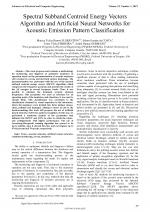| 3/2019 - 6 |
| Extra paper information in |
| Click to see author's profile in |
| Download PDF |
Author keywords
acoustic emission, artificial neural networks, condition monitoring, corona, insulators
References keywords
power(10), insulators(9), networks(7), insulation(7), systems(6), partial(6), neural(6), acoustic(6), outdoor(5), speech(4)
Blue keywords are present in both the references section and the paper title.
About this article
Date of Publication: 2019-08-31
Volume 19, Issue 3, Year 2019, On page(s): 49 - 56
ISSN: 1582-7445, e-ISSN: 1844-7600
Digital Object Identifier: 10.4316/AECE.2019.03006
Web of Science Accession Number: 000486574100006
SCOPUS ID: 85072171267
Abstract
This work proposes and evaluates a methodology for monitoring and diagnosis of polymeric insulators in operation based on the parameterization of acoustic emissions (AE) created by corona and electrical surface discharges. The parameterization was performed with the use of the spectral subband centroid energy vectors (SSCEV) algorithm, which compresses the frequency spectrum and presents the results of the AE energies in several frequency bands. Thus, it was possible to calculate the dominant acoustic emission frequencies. This parameter was used as reference for an operating point of the insulators and, therefore, it was used to classify them. This classification was correlated to the classification obtained by visual inspection in the laboratory, where the insulators were divided into three distinct classes: clean, polluted and damaged. Aiming to insert an aid to the decision-making, this work still proposes the use of artificial neural networks (ANN) for pattern recognition. In this way, we performed a sensitivity analysis of the parameters that influence the SSCEV and ANN, in order to obtain the values and configurations with higher performance. The use of Levenberg-Marquardt training algorithm has proved to be more suitable, since it showed hit rates and convergence up to 97.66 percent and 70 epochs, respectively. |
| References | | | Cited By |
Web of Science® Times Cited: 2 [View]
View record in Web of Science® [View]
View Related Records® [View]
Updated today
SCOPUS® Times Cited: 2
View record in SCOPUS® [Free preview]
View citations in SCOPUS® [Free preview]
[1] Characterization and Analysis of Coalescence Nature of Sessile Droplet on Hydrophobic and Hydrophilic Insulator Surfaces, Indirajith, K., Jaya, N., Kumar, C. Naveen, Arabian Journal for Science and Engineering, ISSN 2193-567X, Issue 11, Volume 47, 2022.
Digital Object Identifier: 10.1007/s13369-022-06748-y [CrossRef]
[2] Application of Motion Sensor Based on Neural Network in Basketball Technology and Physical Fitness Evaluation System, Yuan, Bin, Kamruzzaman, M. M., Shan, Shaonan, Wu, Wenqing, Wireless Communications and Mobile Computing, ISSN 1530-8669, Issue 1, Volume 2021, 2021.
Digital Object Identifier: 10.1155/2021/5562954 [CrossRef]
Disclaimer: All information displayed above was retrieved by using remote connections to respective databases. For the best user experience, we update all data by using background processes, and use caches in order to reduce the load on the servers we retrieve the information from. As we have no control on the availability of the database servers and sometimes the Internet connectivity may be affected, we do not guarantee the information is correct or complete. For the most accurate data, please always consult the database sites directly. Some external links require authentication or an institutional subscription.
Web of Science® is a registered trademark of Clarivate Analytics, Scopus® is a registered trademark of Elsevier B.V., other product names, company names, brand names, trademarks and logos are the property of their respective owners.
Faculty of Electrical Engineering and Computer Science
Stefan cel Mare University of Suceava, Romania
All rights reserved: Advances in Electrical and Computer Engineering is a registered trademark of the Stefan cel Mare University of Suceava. No part of this publication may be reproduced, stored in a retrieval system, photocopied, recorded or archived, without the written permission from the Editor. When authors submit their papers for publication, they agree that the copyright for their article be transferred to the Faculty of Electrical Engineering and Computer Science, Stefan cel Mare University of Suceava, Romania, if and only if the articles are accepted for publication. The copyright covers the exclusive rights to reproduce and distribute the article, including reprints and translations.
Permission for other use: The copyright owner's consent does not extend to copying for general distribution, for promotion, for creating new works, or for resale. Specific written permission must be obtained from the Editor for such copying. Direct linking to files hosted on this website is strictly prohibited.
Disclaimer: Whilst every effort is made by the publishers and editorial board to see that no inaccurate or misleading data, opinions or statements appear in this journal, they wish to make it clear that all information and opinions formulated in the articles, as well as linguistic accuracy, are the sole responsibility of the author.



